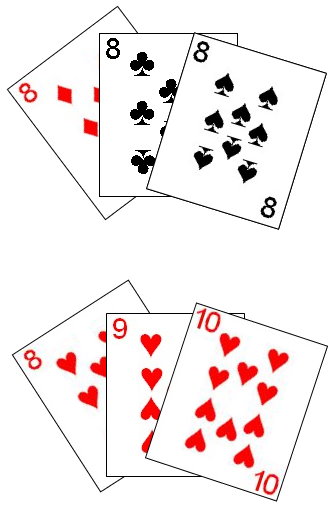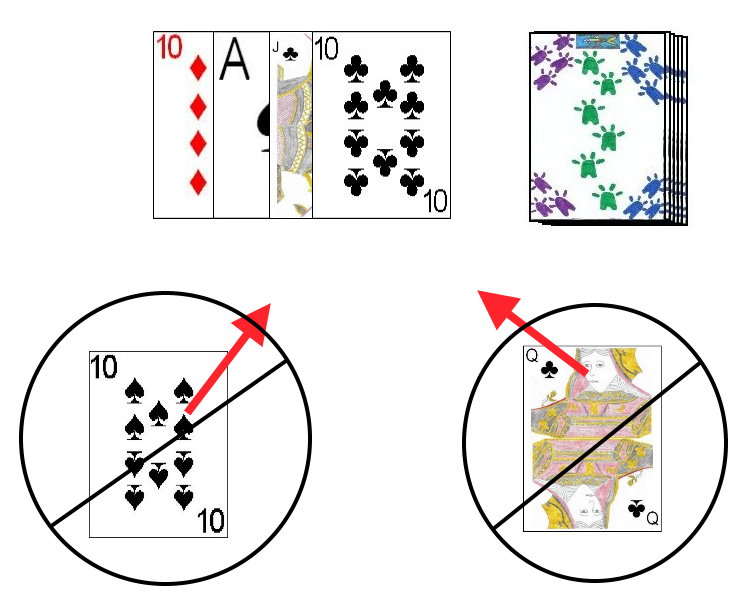Proter is a Rummy type game which is commonly played in Sri Lanka, but is quite rare elsewhere. The game somewhat resembles Pay Me and similar games but also has some unique features of it's own. Proter is designed to be played by 2 to 7 players using one standard 52 card deck. The ranking of the cards in the deck as used by this game are as follows (from high to low); King, Queen, Jack, 10, 9, 8, 7, 6, 5, 4, 3, 2, Ace.
Determination of the first dealer and seating positions can be performed using a variety of methods, with draw for high cards common. To use that method, each player would draw one card from the shuffled deck, taking seats at the table in the order from highest card drawn to lowest. The player drawing the highest card of all would be set as the first dealer and thereafter the role of dealer rotates from player to player in a counter-clockwise direction. One player should also be provided with a sheet of paper and a pencil and he will be the scorekeeper (or marker) for the game.
Once all players are seated and the first dealer determined, this dealer would thoroughly shuffle the deck and offer it to the player at his left to cut. After the cut, the dealer would then begin dealing cards, one by one and face-down starting with the player at his immediate right. He continues dealing the cards in a counter-clockwise direction until each player has six cards. He then places the remainder of the deck face-down in the center of the table as the draw pile. The dealer does not expose the top of the stock pile to start a discard pile as is commonly done in most other Rummy type games.
The game is played over the course of 13 hands, and the player with the lowest accumulated score after all the hands have been played is declared the winner. Each round, a different rank of card is considered wild for the hand. The selected wild card for the hand is called the "Proter". For the first hand, the Ace is considered the Proter, for the second hand the two is considered the Proter, all the way up to the last hand in which the King is considered the Proter for that hand. This wild card can substitute for any other card in a legal meld.
 The player to the immediate right of the dealer has the first turn, and the turns rotate around the table in a counter-clockwise direction.
The player to the immediate right of the dealer has the first turn, and the turns rotate around the table in a counter-clockwise direction.
A player's turn consists of several actions, as follows:
- To start his turn, a player must first draw a card. He may either draw the top, face-down card from the stock or he must draw the entire discard pile, taking this entire pile into his hand.
- After drawing, the player may then optionally choose to make any legal melds from his hand. The legal meld types (or sets) in this game are:
- Three or more cards of the exact same denomination, such as three eights.
- Three or more cards in direct sequence, all of the same suit (such as 8, 9, 10 all of Hearts). The lowest allowable card in a sequence is a two and the highest is the Ace (in other words, sequences may not go around the corner).
The first meld a player makes on his turn may not contain any Proters (wild cards), but subsequent melds may contain one or more Proters within the meld.
A player is restricted from melding any card (either as part of a new meld or adding to an existing meld) to the table in which that same card is already represented on the table. For instance, a player could not play the ten of Diamonds to the table, if there is already a card on the table representing this card in any meld (which would be a Proter). If a player does this without noticing, he is subject to a special penalty (see Penalties section below). - A player may also optionally add to existing melds already found on the table, whether these melds were made by this player or another player. In addition, during his turn, if a player has the natural card for which a Proter is substituted in a meld, the player can replace the Proter with that natural card and add the Proter into his hand for his own use.
- To complete his turn, a player discards any one card from his hand to the discard pile. For the first player of the game, there will not yet be a discard pile, his first discard will
thus start the discard pile. In addition, if a player as his draw
opted to take the discard pile, his discard at the end of his turn will
start a new discard pile. The discards should be placed in such a way
that each previous card in the discard pile is partially visible.
 There are a few special rules about discards in this game. A player may never discard a card of the same rank as the current top card of that discard pile. Additionally, a player may never place a card on the discard pile that would create a sequence of three cards of the same suit with the current top two cards of the discard pile. If a player violates either of these restrictions he is subject to a penalty as described below.
There are a few special rules about discards in this game. A player may never discard a card of the same rank as the current top card of that discard pile. Additionally, a player may never place a card on the discard pile that would create a sequence of three cards of the same suit with the current top two cards of the discard pile. If a player violates either of these restrictions he is subject to a penalty as described below.
- If a player plays a card to the table which is already represented on the table, he incurs a penalty, which earns the player 20 points and forces all actions done during that turn to be undone at the completion of the turn.
- If a player violates one of the discard rules as specified above, he also incurs a penalty of 20 points and all actions during the same turn are reversed and the turn passes to the next player in a counter-clockwise direction.
- At the end of a hand, if a player has one or more Proters in his hand, he incurs a 20 point penalty.
- At the end of hand, if a player did not create at least one new meld to the table, he incurs a 20 point penalty.
- If a player touches the discard pile or the draw pile during any other player's turn, that player incurs a 20 point penalty.
| Card | Point Value |
| King | 13 |
| Queen | 12 |
| Jack | 11 |
| 2, 3, 4, 5, 6, 7, 8, 9, 10 | Value marked on face of card |
| Ace | 1 |